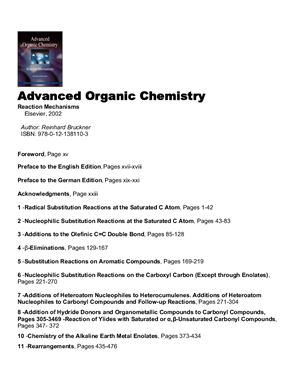Elsevier, 2002. - 636 p.
The student of contemporary organic chemistry will be well-served by the depth and quality of this treatment. The underlying philosophy of this text is that much of chemistry can be understood in terms of structure, which in tu influences reactivity, ultimately defining the higher order activities of synthesis.Whether one seeks to understand nature or to create the new materials and medicines of the future, a key starting point is thus understanding structure and mechanism. This is a wonderfully rich treatment of organic chemistry that will be a great value to students at any level. Education should enable and empower. This text does both, providing the student with the insights and tools needed to address the tremendous challenges and opportunities in the field.
=========================================================
В данной книге представлены основные типы органических реакций и их механизмы. Особое внимание уделяется структуре соединений и их устойчивости. Книга рекомендована для студентов, аспирантов и преподавателей химических ВУЗов.
Contents
Foreword
Preface to the English Edition
Preface to the German Edition
Acknowledgments
Radical Substitution Reactions at the Saturated C Atom
Nucleophilic Substitution Reactions at the Saturated C Atom
Additions to the Olefinic C=C Double Bond
?-Eliminations
Substitution Reactions on Aromatic Compounds
Nucleophilic Substitution Reactions on the Carboxyl Carbon (Except through Enolates)
Additions of Heteroatom Nucleophiles to Heterocumulenes. Additions of Heteroatom Nucleophiles to Carbonyl Compounds and Follow-up Reactions
Addition of Hydride Donors and Organometallic Compounds to Carbonyl Compounds
Reaction of Ylides with Saturated or ?,?-Unsaturated Carbonyl Compounds,
Chemistry of the Alkaline Earth Metal Enolates
Rearrangements
Thermal Cycloadditions
Transition Metal-Mediated Alkenylations, Arylations, and Alkynylations
Oxidations and Reductions
Subject Index
The student of contemporary organic chemistry will be well-served by the depth and quality of this treatment. The underlying philosophy of this text is that much of chemistry can be understood in terms of structure, which in tu influences reactivity, ultimately defining the higher order activities of synthesis.Whether one seeks to understand nature or to create the new materials and medicines of the future, a key starting point is thus understanding structure and mechanism. This is a wonderfully rich treatment of organic chemistry that will be a great value to students at any level. Education should enable and empower. This text does both, providing the student with the insights and tools needed to address the tremendous challenges and opportunities in the field.
=========================================================
В данной книге представлены основные типы органических реакций и их механизмы. Особое внимание уделяется структуре соединений и их устойчивости. Книга рекомендована для студентов, аспирантов и преподавателей химических ВУЗов.
Contents
Foreword
Preface to the English Edition
Preface to the German Edition
Acknowledgments
Radical Substitution Reactions at the Saturated C Atom
Nucleophilic Substitution Reactions at the Saturated C Atom
Additions to the Olefinic C=C Double Bond
?-Eliminations
Substitution Reactions on Aromatic Compounds
Nucleophilic Substitution Reactions on the Carboxyl Carbon (Except through Enolates)
Additions of Heteroatom Nucleophiles to Heterocumulenes. Additions of Heteroatom Nucleophiles to Carbonyl Compounds and Follow-up Reactions
Addition of Hydride Donors and Organometallic Compounds to Carbonyl Compounds
Reaction of Ylides with Saturated or ?,?-Unsaturated Carbonyl Compounds,
Chemistry of the Alkaline Earth Metal Enolates
Rearrangements
Thermal Cycloadditions
Transition Metal-Mediated Alkenylations, Arylations, and Alkynylations
Oxidations and Reductions
Subject Index

